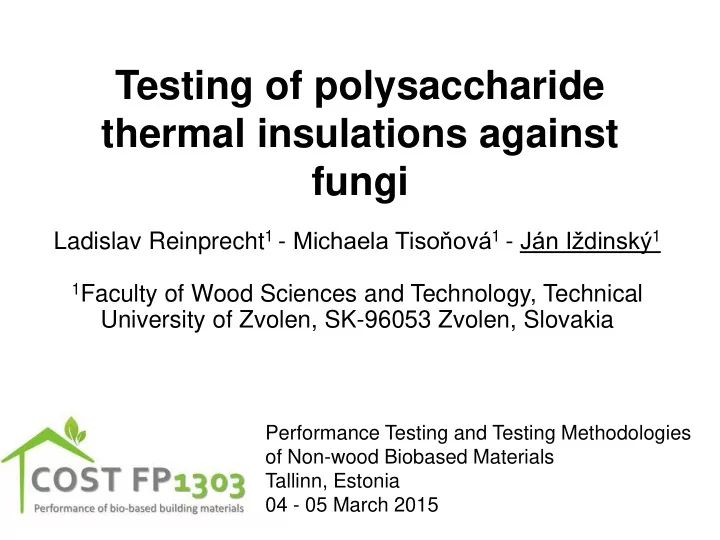

Testing of polysaccharide thermal insulations against fungi Ladislav Reinprecht 1 - Michaela Tisoňová 1 - Ján Iždinský 1 1 Faculty of Wood Sciences and Technology, Technical University of Zvolen, SK-96053 Zvolen, Slovakia Performance Testing and Testing Methodologies of Non-wood Biobased Materials Tallinn, Estonia 04 - 05 March 2015
Testing of polysaccharide thermal insulations against fungi This work discusses decay resistance of: (1) the commercial thermal Cellulose Fibre Insulation containing boric acid in a function of the biocide and fire retardant (Climatizer Plus – CFI); (2) three potential thermal insulations from polysaccharide wastes (Pulp and paper sludge – PPS). Toxic chemical elements in the pulp and paper sludge – PPS Amount [mg.kg -1 ] Type of PPS As Cd Cr Cu Hg Mo Ni Pb Zn PPS-1 7.9 2.8 8.7 85.0 0.3 2.8 2.8 15.0 182.0 PPS-2 14.7 0.5 15.4 56.9 0.8 3.5 2.4 5.2 77.8 PPS-3 1.0 0.5 8.9 17.1 0.7 6.4 4.2 8.4 25.6
Testing of polysaccharide thermal insulations against fungi Methodology of test against fungi Biological resistance tests - sterile laboratory conditions. Samples of fluffy insulations - sewn (polyethylene thread) - into polyethylene bags. Bags - imposed into Petri dishes with agar-malt soil and fungal mycelia (EN 113), - the dry rot fungus ( Serpula lacrymans / Wulfen / J. Schrőt) - the timber gill polypore ( Gloeophyllum trabeum / Pers. / Murrill) The bags opened - the insulations dried, cooled and weighed in oven dry state and the mass losses m determined. 0 Δm (%) [(m m ) / m ] . 100 0 - F 0 Mycological test of polysaccharide thermal insulations against Serpulalacrymans (S.l.)
Testing of polysaccharide thermal insulations against fungi Results Polysaccharide thermal insulations from the pulp and paper sludge better resisted to decaying fungi as the commercial cellulose fibre insulation Climatizer Plus (CFI) m - mass loss [%] Type of sample Serpula lacrymans Gloeophyllum trabeum CFI 14.90 19.07 PPS-1 2.36 6.94 PPS-2 3.41 7.85 PPS-3 4.48 9.05 Pine-solid 25.15 19.57 For a potential application of the PPS insulations in practice, there a very important will be mainly their healthiness, e.g. removal of the most dangerous chemical elements – arsenic, chrome, mercury and lead. However, it can be technically and economically a very difficult task.
Acknowledgments : This work was supported by the Slovak Research and Development Agency under the contract No. APVV-0200-12. The authors would like to thank also to the COST FP1303.
Recommend
More recommend